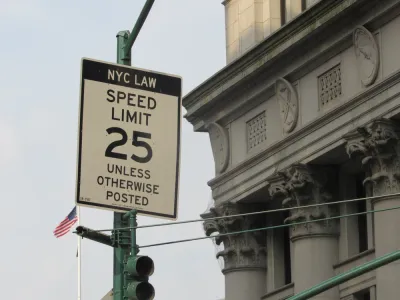Advocates hope the city’s plan to install speed governors on part of its municipal fleet will prompt other cities and government agencies to follow suit.

Because regulating the design of cars and trucks is the purview of the National Highway Traffic Safety Administration (NHTSA), local and state governments in the United States don’t have the power to require safety features not included in federal law. But as David Zipper writes for Bloomberg CityLab, “an intriguing move in New York City suggests a possible workaround: Even if cities and states can’t regulate motor vehicle design, they still wield power over their own sizable fleets.”
A pilot program announced by New York City Mayor Eric Adams last week will install speed governors on 50 city-owned cars. As Zipper explains, “intelligent speed assistance (ISA) uses geolocation to adjust the allowable speed as the posted speed limit changes during a journey. If a driver hits the maximum threshold, the ISA system applies resistance to the accelerator and makes it more difficult (if not impossible) to go faster.”
The program, if expanded to more vehicles, could bring an added benefit by setting the tone for other drivers. “A handful of vehicles driving at the speed limit can force those behind them to follow suit, amplifying safety benefits.”
The article quotes National Transportation Safety Board Chair Jennifer Homendy, who is supportive of cities making similar efforts to install ISA in municipal fleets. “I think it would move the ball forward to get this technology in the market,” Homendy said, which could encourage automakers to make the feature available on more vehicles. As Zipper concludes, “As with seatbelts, airbags and other once-controversial safety advances, driver familiarity could make it easier for Congress and NHTSA to make them mandatory, as Europe has.”
FULL STORY: Why New York City’s Car Safety Pilot Is a Big Deal

National Parks Layoffs Will Cause Communities to Lose Billions
Thousands of essential park workers were laid off this week, just before the busy spring break season.

Retro-silient?: America’s First “Eco-burb,” The Woodlands Turns 50
A master-planned community north of Houston offers lessons on green infrastructure and resilient design, but falls short of its founder’s lofty affordability and walkability goals.

Delivering for America Plan Will Downgrade Mail Service in at Least 49.5 Percent of Zip Codes
Republican and Democrat lawmakers criticize the plan for its disproportionate negative impact on rural communities.

Test News Post 1
This is a summary

Test News Headline 46
Test for the image on the front page.

Balancing Bombs and Butterflies: How the National Guard Protects a Rare Species
The National Guard at Fort Indiantown Gap uses GIS technology and land management strategies to balance military training with conservation efforts, ensuring the survival of the rare eastern regal fritillary butterfly.
Urban Design for Planners 1: Software Tools
This six-course series explores essential urban design concepts using open source software and equips planners with the tools they need to participate fully in the urban design process.
Planning for Universal Design
Learn the tools for implementing Universal Design in planning regulations.
EMC Planning Group, Inc.
Planetizen
Planetizen
Mpact (formerly Rail~Volution)
Great Falls Development Authority, Inc.
HUDs Office of Policy Development and Research
NYU Wagner Graduate School of Public Service





























